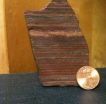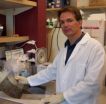(Press-News.org) RIVERSIDE, Calif. – A team of scientists, led by biogeochemists at the University of California, Riverside, has found new evidence linking "Snowball Earth" glacial events to the rise of early animals.
The controversial Snowball Earth hypothesis posits that the Earth was covered from pole to pole by a thick sheet of ice lasting, on several occasions, for millions of years. These glaciations, the most severe in Earth history, occurred from 750 to 580 million years ago. The researchers argue that the oceans in the aftermath of these events were rich in phosphorus, a nutrient that controls the abundance of life in the oceans.
The UC Riverside team and colleagues tracked phosphorus concentrations through Earth's history by analyzing the composition of iron-rich chemical precipitates that accumulated on the seafloor and scavenged phosphorus from seawater. Their analyses revealed that there was a pronounced spike in marine phosphorus levels in the mid-Neoproterozoic (from ~750 to ~635 million years ago).
To explain these anomalously high concentrations, the researchers argue that the increase in erosion and chemical weathering on land that accompanied Snowball Earth glacial events led to the high amounts phosphorus in the ocean. The abundance of this nutrient, which is essential for life, in turn, led to a spike in oxygen production via photosynthesis and its accumulation in the atmosphere, facilitating the emergence of complex life on Earth.
Study results appear in the Oct. 28 issue of Nature.
"In the geological record, we found a signature for high marine phosphorus concentrations appearing in the immediate aftermath of the Snowball Earth glacial events," said Noah Planavsky, the first author of the research paper and a graduate student in the Department of Earth Sciences. "Phosphorus ultimately limits net primary productivity on geological timescales. Therefore, high marine phosphorus levels would have facilitated a shift to a more oxygen-rich ocean-atmosphere system. This shift could have paved the way for the rise of animals and their ecological diversification. Our work provides a mechanistic link between extensive Neoproterozoic glaciations and early animal evolution."
Planavsky explained the link between marine phosphorus concentrations and the levels of oxygen in the atmosphere.
"High phosphorus levels would have increased biological productivity in the ocean and the associated production of oxygen by photosynthesis," he said. "Much of this organic matter is consumed, in turn, as a result of respiration reactions that also consume oxygen. However, the burial of some proportion of the organic matter results in a net increase of oxygen levels in the atmosphere."
Until now, scientists believed that geochemical conditions in the iron-rich ocean would have led to low phosphorus concentrations. The UC Riverside researchers found no evidence of a phosphorus crisis after Snowball Earth glacial events, however, finding instead indications of an abundance of phosphorus.
"There are several known chemical fingerprints for increasing oxygen in the ocean and, by inference, in the atmosphere during the middle part of Neoproterozoic, and the rise of animals is an expected consequence," said Timothy Lyons, a professor of biogeochemistry and the senior investigator in the study. "But our results may be the first to capture the nutrient driver that was behind this major step in the history of life, and that driver was ultimately tied to the extreme climate of the period."
The researchers present data from approximately 700 individual samples of iron-oxide-rich rocks that included new results as well as those obtained from a comprehensive survey of the literature.
INFORMATION:
Planavsky and Lyons were joined in the study by Christopher Reinhard of UC Riverside; Olivier J. Rouxel of Woods Hole Oceanographic Institute, Mass.; Andrey Bekker of the University of Manitoba, Canada; and Stefan V. Lalonde and Kurt O. Konhauser of the University of Alberta, Canada.
The UC Riverside researchers were supported by grants from the National Science Foundation and the NASA Astrobiology Institute and the NASA Exobiology Program.
The University of California, Riverside (www.ucr.edu) is a doctoral research university, a living laboratory for groundbreaking exploration of issues critical to Inland Southern California, the state and communities around the world. Reflecting California's diverse culture, UCR's enrollment has exceeded 20,500 students. The campus will open a medical school in 2012 and has reached the heart of the Coachella Valley by way of the UCR Palm Desert Graduate Center. The campus has an annual statewide economic impact of more than $1 billion.
A broadcast studio with fiber cable to the AT&T Hollywood hub is available for live or taped interviews. To learn more, call (951) UCR-NEWS.
New evidence supports 'Snowball Earth' as trigger for early animal evolution
A spike in ancient marine phosphorus concentrations from 750 to 635 million years ago is linked to emergence of complex life, UC Riverside researchers say
2010-10-28
ELSE PRESS RELEASES FROM THIS DATE:
Sodas, other sugary beverages linked to increased risk of type 2 diabetes, metabolic syndrome
2010-10-28
Boston, MA—A new study has found that regular consumption of soda and other sugar-sweetened beverages is associated with a clear and consistently greater risk of metabolic syndrome and type 2 diabetes. According to the Harvard School of Public Health (HSPH) researchers, the study provides empirical evidence that intake of sugary beverages should be limited to reduce risk of these conditions.
The study appears online October 27, 2010, in the journal Diabetes Care and will appear in the November print edition.
"Many previous studies have examined the relationship between ...
Surprise finding: Pancreatic cancers progress to lethal stage slowly
2010-10-28
Pancreatic cancer develops and spreads much more slowly than scientists have thought, according to new research from Johns Hopkins investigators. The finding indicates that there is a potentially broad window for diagnosis and prevention of the disease.
"For the first time, we have a quantifiable estimate of the development of pancreatic cancer, and when it would be best to intervene," according to Christine Iacobuzio-Donahue, M.D., Ph.D., associate professor of pathology and oncology at Hopkins' Sol Goldman Pancreatic Cancer Research Center, "so there is potentially ...
A speed gun for the Earth's insides
2010-10-28
Researchers at the University of Bristol reveal today in the journal Nature that they have developed a seismological 'speed gun' for the inside of the Earth. Using this technique they will be able to measure the way the Earth's deep interior slowly moves around. This mantle motion is what controls the location of our continents and oceans, and where the tectonic plates collide to shake the surface we live on.
For 2,900 km (1800 miles) beneath our feet, the Earth is made of the rocky mantle. Although solid, it is so hot that it can flow like putty over millions of years. ...
Research rejects green tea for breast cancer prevention
2010-10-28
Green tea does not protect against breast cancer. A study of data from approximately 54,000 women, published in BioMed Central's open access journal Breast Cancer Research, found no association between drinking green tea and breast cancer risk.
Motoki Iwasaki, from the National Cancer Center, Tokyo, worked with a team of researchers to carry out the study. He said, "Although in vitro and animal-based studies have suggested that green tea may have beneficial protective effects against breast cancer, results from human studies have been inconclusive. Our large-scale, population-based ...
Forces for cancer spread: Genomic instability and evolutionary selection
2010-10-28
In new research published today, researchers uncover evolution in action in cancer cells. They show the forces of evolution in pancreatic tumours mean that not only is cancer genetically different between different patients, but each new focus of cancer spread within a patient has acquired distinct mutations.
Effectively, ten different foci of cancer spread are ten different, but related, tumours. The complexity of pancreatic cancer genetics uncovered in this work helps to explain the difficulty of treating the disease but also strengthens the need for improved methods ...
60 Utahns are among landmark large-scale genome sequencing study
2010-10-28
(SALT LAKE CITY)—Just seven months after University of Utah geneticists took part in a landmark study that sequenced for the first time the genome of an entire Utah family, U of U researchers have taken part in another historic study that is the first large-scale genome sequencing project – 179 people representing three continents – and 60 Utahns played a major role in this study, too.
Published Wednesday, Oct. 27, 2010, in Nature, the study demonstrates how quickly the science of genome sequencing is expanding – first from individuals, then to families, and now to large ...
'Smart drug' targets new mutation, dramatically shrinks aggressive sarcoma and lung cancer
2010-10-28
BOSTON--A new oral drug caused dramatic shrinkage of a patient's rare, aggressive form of soft-tissue cancer that was driven by an abnormally activated protein, physician-scientists from Dana-Farber Cancer Institute report in the Oct. 28 issue of the New England Journal of Medicine.
A second patient who had a similar tumor that was not fueled by the mutant protein, called ALK (named for the first disease in which it was found, anaplastic lymphoma kinase), failed to respond to the drug, said the researchers, confirming the inhibitor's specificity for the abnormal protein. ...
New methods detect subtleties in human genomes' repetitive landscapes
2010-10-28
Scientists have invented methods to scout the human genome's repetitive landscapes, where DNA sequences are highly identical and heavily duplicated. These advances, as reported today in Science, can identify subtle but important differences among people in the number and content of repeated DNA segments.
These copy number variations partly account for the normal diversity among people. Copy number variations might also be why some people, and not others, have certain disorders or disease susceptibilities, and might also determine how severely they are affected.
Until ...
Certain cancer therapies' success depends on presence of immune cell, Stanford study shows in mice
2010-10-28
STANFORD, Calif. — The immune system may play a critical role in ensuring the success of certain types of cancer therapies, according to a new study by researchers at the Stanford University School of Medicine. The research showed treatments that disable cancer-promoting genes called oncogenes are much more successful in eradicating tumors in the presence of a signaling molecule secreted by kind of immune cell called a T helper cell.
The finding is important because many drugs now in use in humans are often tested in lab animals with weakened immune systems and many human ...
Controlling individual cortical nerve cells by human thought
2010-10-28
PASADENA, Calif.—Five years ago, neuroscientist Christof Koch of the California Institute of Technology (Caltech), neurosurgeon Itzhak Fried of UCLA, and their colleagues discovered that a single neuron in the human brain can function much like a sophisticated computer and recognize people, landmarks, and objects, suggesting that a consistent and explicit code may help transform complex visual representations into long-term and more abstract memories.
Now Koch and Fried, along with former Caltech graduate student and current postdoctoral fellow Moran Cerf, have found ...
LAST 30 PRESS RELEASES:
New expert guidance urges caution before surgery for patients with treatment-resistant constipation
Solar hydrogen can now be produced efficiently without the scarce metal platinum
Sleeping in on weekends may help boost teens’ mental health
Study: Teens use cellphones for an hour a day at school
After more than two years of war, Palestinian children are hungry, denied education and “like the living dead”
The untold story of life with Prader-Willi syndrome - according to the siblings who live it
How the parasite that ‘gave up sex’ found more hosts – and why its victory won’t last
When is it time to jump? The boiling frog problem of AI use in physics education
Twitter data reveals partisan divide in understanding why pollen season's getting worse
AI is quick but risky for updating old software
Revolutionizing biosecurity: new multi-omics framework to transform invasive species management
From ancient herb to modern medicine: new review unveils the multi-targeted healing potential of Borago officinalis
Building a global scientific community: Biological Diversity Journal announces dual recruitment of Editorial Board and Youth Editorial Board members
Microbes that break down antibiotics help protect ecosystems under drug pollution
Smart biochar that remembers pollutants offers a new way to clean water and recycle biomass
Rice genes matter more than domestication in shaping plant microbiomes
Ticking time bomb: Some farmers report as many as 70 tick encounters over a 6-month period
Turning garden and crop waste into plastics
Scientists discover ‘platypus galaxies’ in the early universe
Seeing thyroid cancer in a new light: when AI meets label-free imaging in the operating room
Neutrophil-to-lymphocyte ratio may aid risk stratification in depressive disorder
2026 Seismological Society of America Annual Meeting
AI-powered ECG analysis offers promising path for early detection of chronic obstructive pulmonary disease, says Mount Sinai researchers
GIMM uncovers flaws in lab-grown heart cells and paves the way for improved treatments
Cracking the evolutionary code of sleep
Medications could help the aging brain cope with surgery, memory impairment
Back pain linked to worse sleep years later in men over 65, according to study
CDC urges ‘shared decision-making’ on some childhood vaccines; many unclear about what that means
New research finds that an ‘equal treatment’ approach to economic opportunity advertising can backfire
Researchers create shape-shifting, self-navigating microparticles
[Press-News.org] New evidence supports 'Snowball Earth' as trigger for early animal evolutionA spike in ancient marine phosphorus concentrations from 750 to 635 million years ago is linked to emergence of complex life, UC Riverside researchers say



